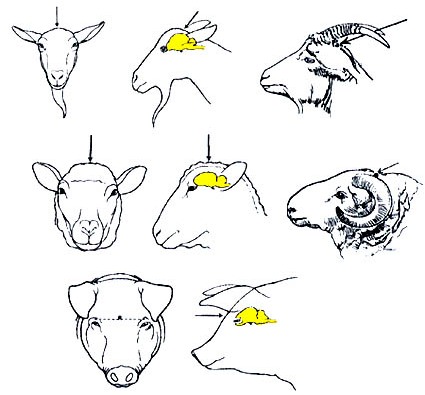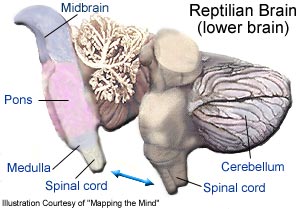The Brain is the control center of the body, because it is the part of the brain that receives messages, interprets them, and then respond to them by enabling us to move, speak, show emotion, and controls automatic functions such as heart rate, breathing, sweating, elimination, etc. Following is a brief description of the brain structures, which are important parts of what happens when the brain is injured.
There are three primary areas of the brain:
- The Brainstem connects the brain to the spinal cord and consists of:
- The midbrain, pons, and medulla oblongata, which control consciousness, arousal, and vital functions such as breathing, blood pressure, and pulse rate
- Cranial nerves # I - XII, which control:
- Smell - I. Olfactory nerve
- Vision and associated reflexes - II. Optic nerve
- Eye movements - III. Oculomotor, IV. Trochlear, and VI. Abducens nerves
- Chewing, swallowing, movement of ear ossicles, general sensations of face, nose, mouth and meninges, and visceral sensitivity - V. Trigeminal nerve
- Facial expression, tearing, salivating, taste, vasodilation, visceral sensibility, movement of the stapes in the ear, swallowing movements, and general senses in the back part of the tongue and throat - VII. Facial and IX. Glossopharyngeal nerves
- Hearing and balance - VIII. Vestibulocochlear nerve
- Control of the larynx and viscera, movement of the soft palate, pharynx, and larynx, visceral sensitivity, and taste - X. Vagus nerve
- Movements of shoulder and head - XI. Accessory nerve
- Movements of tongue - XII. Hypoglossal nerve
- The Cerebellum is cupped around the brainstem and controls muscle coordination, balance, and voluntary movements
- The Cerebral Cortex, the largest area of the brain, is where most thinking functions occur. The cortex consists of four lobes:
- The Frontal Lobe controls emotion, motivation, social functioning, expression of behavior, voluntary movement, and "executive" functions, such as initiation, planning, thought organization, and decision making
- The Temporal Lobe controls memory, receptive language, sequencing, and musical awareness
- The Parietal Lobe controls sensation, academic skills such as reading, hearing, and awareness of spatial relationships
- The Occipital Lobe controls visual perception
The cortex is further divided into two halves, or hemispheres. The dominant hemisphere, usually the left, controls verbal functions such as speaking, writing, reading, and calculating. The right hemisphere controls functions that are more visual in nature, such as memory, drawing, or copying.
Snake Brain
Ant Brain
Horse Brain
Lion Brain
Similar Threads:



 Attention Guest, if you are not a member of Urdu Tehzeb, you have 1 new private message waiting, to view it you must fill out
Attention Guest, if you are not a member of Urdu Tehzeb, you have 1 new private message waiting, to view it you must fill out 


















 Reply With Quote
Reply With Quote



Bookmarks